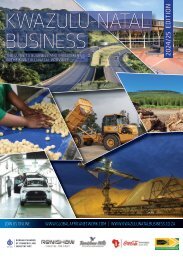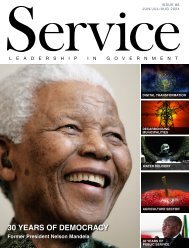Blue Chip Journal - June 2019 edition
Create successful ePaper yourself
Turn your PDF publications into a flip-book with our unique Google optimized e-Paper software.
RETIREMENT FUNDS<br />
Smoke and mirrors<br />
Some tough questions for the<br />
retirement fund industry<br />
The power of compound interest is<br />
a miraculous thing when it works<br />
in your favour, but it is disastrous<br />
when it works against you.<br />
All manner of laws and regulations have<br />
been passed in South Africa to better<br />
protect investors from the predations<br />
of retirement fund administrators and<br />
managers who have developed some<br />
ingenious ways of squeezing an extra<br />
fraction of a percent, and in many cases<br />
much more, out of your savings. Over the<br />
long term, this adds up to a tidy sum.<br />
While there is no doubt that some of<br />
the more rapacious practices of the past<br />
have been stymied by these laws and<br />
regulations, from my experience, many<br />
retirement fund administrators and<br />
managers just got smarter at disguising<br />
their parasitic behaviour. This behaviour<br />
renders these laws and regulations<br />
meaningless.<br />
High fees are disguised<br />
in a variety of ways<br />
The average person is simply not equipped<br />
to detect when they are being fleeced.<br />
That’s because the fees are disguised in<br />
a variety of ways. The retirement fund<br />
industry has become a game of smoke and<br />
mirrors. Company CEOs or chief financial<br />
officers are bamboozled by retirement fund<br />
investment rankings showing Fund X in the<br />
upper quartile. What they are not seeing<br />
is the slow but inexorable rape of their<br />
employees’ savings.<br />
A few years ago National Treasury<br />
released a paper entitled “Charges in<br />
South African retirement funds” which<br />
should have shamed the industry but<br />
apparently didn’t. South African fee<br />
structures compare poorly with our<br />
overseas peers; they lack transparency and<br />
are not particularly comparable, especially<br />
when it comes to umbrella funds. Nor are<br />
they readily “portable” (easy to migrate<br />
to a new fund). Pricing is so complex you<br />
need a professional to explain the costs<br />
and terms. Making matters worse is the<br />
fact that intermediaries are incentivised<br />
to sell the products of specific service<br />
providers, creating an unnatural swing<br />
towards high-cost funds.<br />
The retirement industry is awash with<br />
flexible funds and differentiated products<br />
and services, creating such a complex and<br />
layered landscape that no-one can make<br />
sense of it. You might be tempted to think<br />
that this is the magic of the free market<br />
at work, but it has the pernicious effect<br />
of embedding the incumbents, allowing<br />
outrageous fees to pass unnoticed and<br />
raising industry barriers to entry. The<br />
actual effect is to stifle price competition.<br />
An actual example<br />
Let me illustrate by way of an example.<br />
We recently did an exercise for a JSElisted<br />
company with roughly R300-million<br />
in retirement assets and more than 500<br />
members. We did a cost comparison to see<br />
what the fund would look like if different<br />
default investment options had been<br />
availed. What we found was a potential<br />
saving of over R1- million a year. On a R300-<br />
million fund that’s not much, you might say.<br />
But it is when you compound it over 20, 30<br />
or 40 years. One could question the role of<br />
the independent trustees of the umbrella<br />
fund in question in this instance in ensuring<br />
value for money for the members.<br />
The South African retirement<br />
industry in a nutshell<br />
The South African retirement industry is<br />
worth in excess of R3-trillion in assets. That’s<br />
a huge sum of money, with nearly twothirds<br />
of that tied up in the Government<br />
Employee Pension Fund (GEPF),<br />
administered by the Public Investment<br />
Corporation (PIC). Though most of these<br />
assets are administered by the PIC, the<br />
actual investment function, for the most<br />
part, is farmed out to private-sector asset<br />
managers. Judging by cost disclosures on<br />
unit trusts, the average total cost runs at<br />
between 2-3% of assets per year. If one adds<br />
all the costs of running a retirement fund,<br />
that amounts to in excess of R100-billion a<br />
year in fees going to administrators, fund<br />
managers and others in the retirement<br />
fund ecosystem.<br />
Up to 40% of your retirement<br />
has been swallowed in fees<br />
Put another way, these outlandish fees<br />
could cost you 40% of your retirement.<br />
The answer is not necessarily to opt<br />
for the cheapest but rather ensure that<br />
members are receiving value for money,<br />
depending on the type of product or<br />
solution. Much has been written about<br />
passive investment but even there the<br />
difference between the lowest and<br />
highest cost provider is more than<br />
double. However, the focus has to be on<br />
the total cost across the full spectrum.<br />
Paying the industry average of 2-3% of<br />
total cost versus a more palatable cost of<br />
36 www.bluechipjournal.co.za


















